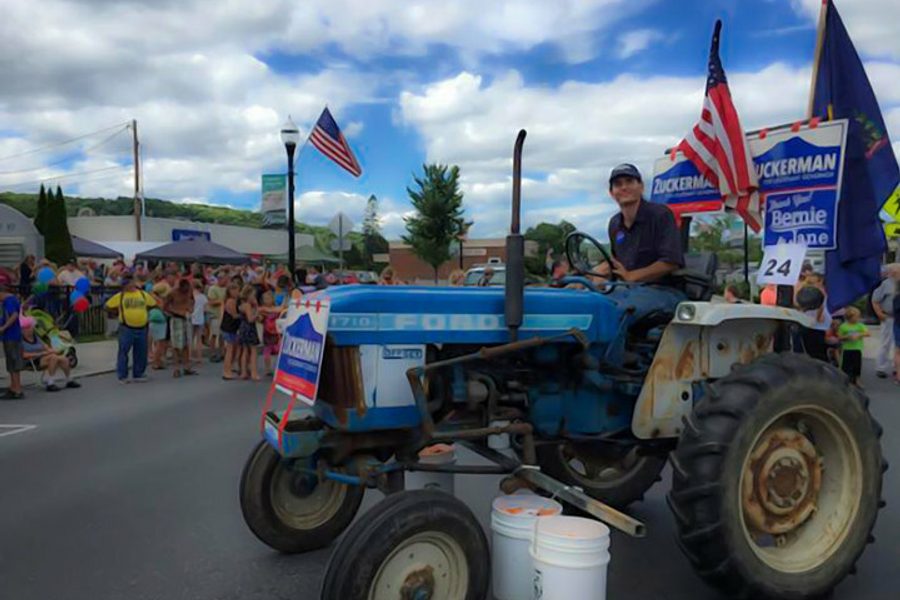Now that the bright lights of the Democratic convention have dimmed, the Sanders army is slowly but surely deploying down-ballot.
Fourteen states held primaries in August. According to the volunteer-run site Berniecrats.net, 210 candidates — a figure that includes local, state and congressional bids — were “Berniecrats,” meaning they endorsed Bernie Sanders and a similar progressive platform. Roughly half claimed victory. Since the primary season began March 1, Berniecrats have won 238 of 379 races, or 62.8 percent.
The Bernie effect was on strong display in Vermont’s August 9 primaries. Thirty-six of the 40 Berniecrats won.
Some, like David Zuckerman, pulled off decisive, groundbreaking victories. A straight-shooting, tractor-driving organic farmer and state legislator, Zuckerman won the Democratic primary for lieutenant governor. Zuckerman was up against two opponents, including House Speaker Shap Smith, a Democratic establishment darling. Rights and Democracy, a local progressive advocacy group, called Zuckerman’s victory a “progressive earthquake to Vermont’s political establishment.”
Zuckerman got involved in electoral politics in 1992, while a student at the University of Vermont. Two years earlier, Bernie Sanders had won Vermont’s single U.S. House seat as an Independent. “I was cynical about the two-party system of our electoral arena,” says Zuckerman, “and it was Bernie who actually inspired me to engage in the political process.”
In early August, Sanders endorsed Zuckerman for the No. 2 seat in the state. “David is one of the outstanding members of the legislature,” said Sanders, adding that Zuckerman “has earned a reputation as a fighter who is not afraid to stand up to the big money interests.” Like Sanders — and unlike his two opponents — Zuckerman refused to take corporate campaign contributions.
One of the most-heralded Berniecrat victories came August 2, when Washington state voters decisively picked Pramila Jayapal in the primary race for Washington’s 7th Congressional District. She’s expected to handily win the general election.
Jayapal was among 15 Senate and House candidates across 12 states, as well as eight state legislature candidates across seven states, who received financial backing from the Sanders campaign. Not all sailed to victory — House candidate Eric Kingson of New York and Lucy Flores of Nevada lost their June primaries, and Florida’s challenger to Debbie Wasserman Schultz, Tim Canova, lost on August 30. But August was a good month overall for high-profile Sanders endorsees. Russ Feingold won the Democratic nod for one of Wisconsin’s U.S. Senate seats, and Paul Clements won the Democratic primary for Michigan’s 6th Congressional District.
You betcha, Minnesota
A former refugee from Somalia made history in Minneapolis-St. Paul when she beat out a long-serving legislator in the state’s August 9 primary. Ilhan Omar, 33, ably defeated incumbent Phyllis Kahn, who has represented the district for 44 years. The historic victory made Omar the first Somali Muslim-American woman to win a state primary in Minnesota. Favored to win in November, she is on the brink of becoming the nation’s first Somali-American lawmaker.
Sanders did not formally endorse Omar until after the primaries, but she still benefited from a Bernie boost, says her campaign manager, Daniel Anton Cox. The precincts Omar won had especially high turnout compared to 2014, which Cox attributes in part to the fact that “so many people, especially young people, caucused [for Bernie] for the first time.”
“Ilhan waged a campaign that isn’t typical,” says Cox. “She built bridges between communities, and did things that aren’t part of the conventional wisdom of what is possible.”
Omar has been an advocate and organizer in Minneapolis for years in a district that includes East African immigrants, college students and long-term residents. She helped to win paid parental leave for City of Minneapolis employees, pass a city ordinance extending business hours during Ramadan and ban environmentally toxic containers, according to her campaign. On June 20, she walked a picket line with the Minnesota Nurses Association (MNA).
MNA was one of a number of local unions and progressive organizations to endorse Omar, along with AFSCME Local 8, the Minnesota Young Democratic-Farmer-Labor Party, and Outfront Minnesota. At the forefront was Take Action Minnesota, which turned out more than 140 volunteer shifts to help elect Omar.
The economic and racial justice organization has become a power player in Minnesota elections over the past decade. Dan McGrath, Take Action’s executive director, is hopeful that the momentum from the Sanders campaign can spur change, but stresses the need for infrastructure that lasts beyond the election season: “The question for Bernie is, how’s it going to endure? In the case of Ilhan’s race, because TakeAction is a permanent year-around organization, we know the activists that connected with our campaign are going to stay involved. … We want to pass legislation for paid sick days to [benefit] 1 million workers in our state, as well as to restore voting rights for all people on probation and parole — some 47,000 people.”
Look out, Connecticut
On August 9, in Connecticut, Sanders backers claimed victory in 8 of the 9 state primaries in which they ran. Seven were running for state representative seats, and one, Gary Holder-Winfield, for state senate.
Among the winning candidates was Joshua Elliott, 31. Elliott was first politicized when he volunteered for the Sanders campaign in May 2015. After Sanders lost the Connecticut primary in April, the Working Families Party (WFP) encouraged Elliott to run in the Democratic primary for the Hamden, Conn., state house seat. (In Connecticut, whose electoral rules favor a two-party system, WFP uses a “fusion” model, backing progressive candidates in the major-party primaries.) Elliott agreed, and WFP supported him with candidate training and grassroots canvassing.
Elliott told the Connecticut Mirror that his campaign began with a group of Sanders volunteers who wanted to find another way to pursue Bernie-style progressivism. Like Sanders, Elliott says his success is “as little about me as our team can possibly make it.”
Slowly, surely, progress
It’s hard to say whether 238 primary victors, out of hundreds of state and local races, will make a mark on our national political landscape. Not all, of course, will win in November.
However, two statistics are telling: According to Berniecrats.net’s tally, 59 percent of Berniecrats are not incumbents, and 17 percent are first-time candidates. That means that Berniecrats include not just progressive incumbents taking up Sanders’ mantle, but also political outsiders heeding Sanders’ call-to-revolution. Since June, some 11,000 Sanders supporters have signed up to run for office or volunteer for Sanders supporters who do. The pool of support for progressive challengers will grow as groups like Our Revolution (the Sanders campaign’s new down-ballot operation), Brand New Congress, People’s Action, MoveOn.org, WFP and Democracy for America ramp up operations.
Quietly, it seems, the political revolution has begun.







